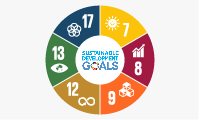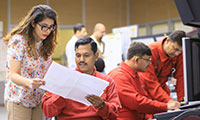Embedding sustainability in projects
Our commitment to safety, the environment and communities plays an important role in how we plan, design and operate projects and facilities. We will continue our relentless focus on managing impacts, especially in the challenging environments where we operate.
When we invest in projects, we aim to balance the short- and long-term interests of our business. For investment decisions, we consider the economic, social and environmental risks and opportunities as well as the political and technical risks.
Shell conducts an environmental, social and health impact assessment for every major project. As part of the impact assessment process, we engage with communities and other stakeholders, for example non-governmental organisations, to discuss possible ways to address their concerns. This helps us understand and better manage the effects our projects could have on the surrounding environment and local communities and to comply with relevant social and environmental regulations.
Our Health, Safety, Security, Environment and Social Performance (HSSE&SP) Control Framework has mandatory requirements to ensure the performance of these impact assessments. We also draw on international standards from bodies such as the World Bank and its International Finance Corporation, to guide our engagement with communities.
Our people
We train our project teams to understand how to use impact assessments to embed sustainability into project decisions. They are supported by specialists in areas such as environmental management, health and social performance including, but not limited to:
- biodiversity, waste, air, energy and water management; and
- indigenous peoples’ rights, cultural heritage and resettlement.
The specialists support project teams on impact assessments and help manage potential impacts on communities or the environment during project design, construction and operation.
For more details, read what sustainability means at Shell on www.shell.com.
New life for an old industrial site
In Pennsylvania, USA, we are building a petrochemicals facility on an existing industrial site used for zinc smelting for around 100 years.
Minimising the impact on people and the local environment is at the heart of our plans.
After the zinc smelter had been safely decommissioned, we recycled the old equipment and waste products. We covered the site with special industrial liners and caps to protect groundwater and surface water and people building the new facility. Where areas of water on the site could not be protected, we created wetlands elsewhere. These have now grown into healthy habitats for fish and vegetation.
We used an emissions offsetting programme to help reduce the impact that building work will have on local air quality. After consulting with local residents and community leaders, we also planted native trees along the nearby river to improve the look of the construction site.
Working closely with the state environmental regulator, we are investing $80 million in mitigating the environmental impacts of converting the industrial site. Once up and running, the plant will produce polyethylene which is used in many everyday products, from food packaging and containers to automotive components.
 Sustainability at Shell
Sustainability at Shell
 Sustainable development goals
Sustainable development goals
 About our data
About our data
 Energy transition and climate change
Energy transition and climate change